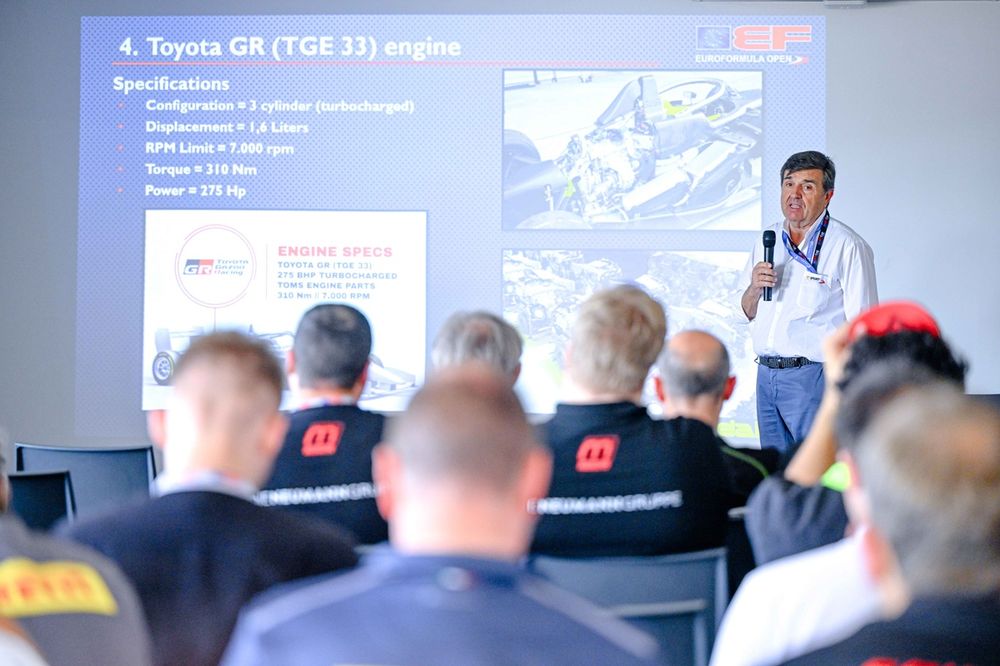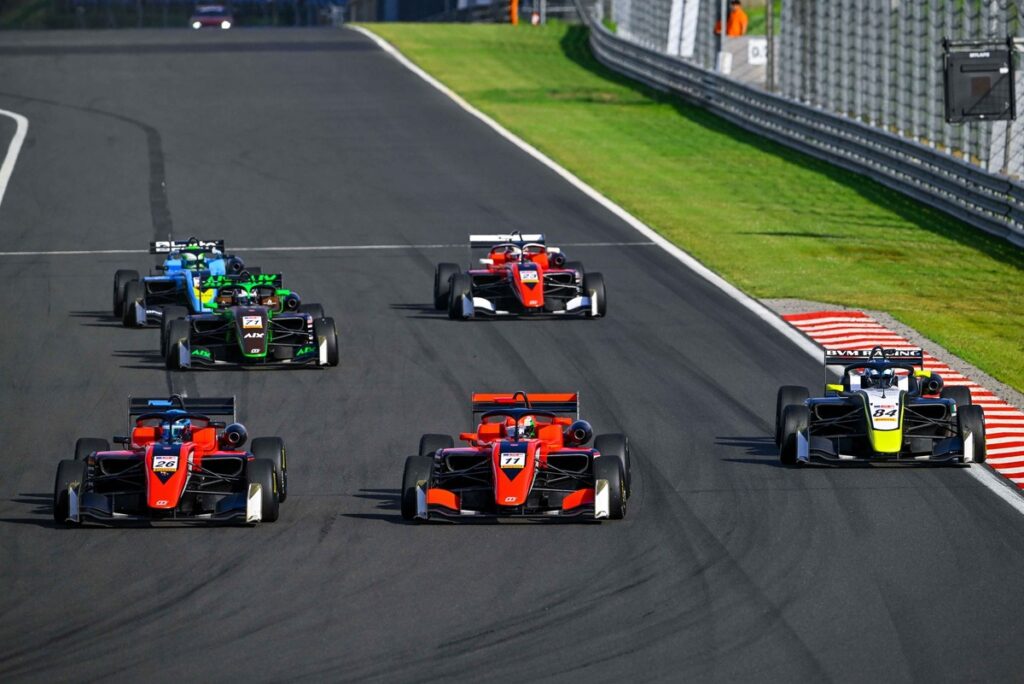Three-cylinder engines are on their way to European single-seaters for 2025, and it looks as though there is every chance that they will revitalise a much-loved category.
Since the demise of the FIA’s old Formula 3 European Championship at the end of 2018, when the ‘F3’ title was given by the governing body to the GP3 Series, the old philosophy of F3 cars have raced on in the Euroformula Open (EFO) series.
In 2019, when EFO featured four drivers who would go on to start Formula 1 grands prix in the past 12 months, as well as a couple of future IndyCar stars, the series continued with the same base Dallara chassis that had been in use since 2012. But since 2020, when the Italian constructor reworked the car into the behaloed 320, grids have steadily diminished to a meagre six to eight competitors last season.
Japan also stayed loyal to the old F3 with the Dallara 320 for its Super Formula Lights (SFL) series, but in 2024 introduced the updated 324 with a new TOM’S-developed Toyota spec engine, and this combination is to be introduced to EFO in 2025.
What makes this engine substantially different to anything that has gone before is that the TOM’S TGE33 is based on the 1.6-litre, three-cylinder turbocharged G16E-GTS out of the Toyota GR Yaris road car. Finally, the 2.0-litre, four-cylinder, air-restricted racing engines – in Europe, the mainstays have been Spiess (formerly badged as Volkswagen in the old European F3 days) and HWA (Mercedes) – in use since 2014 are being pensioned off.
The key for Dallara, says its long-time F3 project leader Jos Claes, is to retain all the characteristics of the old-school cars, even amid such a radical change on the powerplant front.
“F1 drivers come and test the 320, and they say, ‘What a wonderful thing’,” says Claes, an amiable Belgian who has been around the F3 scene for so long you wouldn’t be surprised to find out that he breathes through an air restrictor.
TOM’S TGE33 is proven in Japan and now will become the standard powerplant in EFO
Photo by: Super Formula Lights
“We want to stay as close as possible to the weight and power – we don’t need any more.”
Claes, as someone who cares passionately about this area of the sport – and, of course, has Dallara’s interests to maintain in the arena that brought it to prominence in the first place – was fully involved in conversations with the SFL and EFO organisers.
“We searched for some years for a one-make engine solution,” he explains. “I pushed very hard in Japan for a small, aluminium, preferably atmospheric engine, but they are difficult to find. I said if we cannot find one, maybe this [what became the TGE33] is the engine. The turbo is so small and the engine is so well-designed.”
The most important thing was to keep the weight down in this era of bloated machinery, and the 324 competes at not far off 100kg below the norm in FIA F3 and Formula Regional.
“It’s a bit hard to follow why it’s all of a sudden like this, but I think in the past there’s always been rumours that we got the better engines”
Timo Rumpfkeil
“The good news is we can keep the small tyres,” points out Claes. “When you go to bigger tyres and wheels, you add weight, and then you need to go to bigger brakes. Before you know it, 40kg have arrived.”
Naturally, as with most new racing projects, there were teething problems. While the TGE33 offers more power – 275bhp compared to 220bhp for the old four-cylinder engines – and torque, there was no desire for bigger, heavier gearboxes. SFL’s 2024 season finally kicked off in mid-May following issues with oscillation after gearshifting that were causing input shaft breakages, while there were glitches with bellhousings.
The oscillations were “solved mostly by electronics”, says Claes, “and from round two or three there were no problems.” The result is an engine with maps that include “a very safe one they use”, plus “a boost map for push-to-pass if they want [in the future]”.
German team Motopark, which came close to the 2018 European F3 title but was ostracised from the FIA’s F2/F3 ladder, has dominated EFO in recent seasons. Team boss Timo Rumpfkeil says he will run six cars in 2025.
“We ordered a couple of new cars and the others we update,” he states. “It’s quite a big evolution but it’s still an evolution of the 320. They had a few glitches as you would imagine, but now they run reliably in Japan so that’s good.”

EFO promoter Jesus Pareja will hope that new Toyota unit can boost grids after struggling in 2024
Photo by: Euroformula Open
Rumpfkeil reckons interest is on the upturn. “For a couple of years sluggish,” he sums up, “but the moment they announce it [the 324] we were really significantly up on requests so that’s been good. Not only for us, also for the other teams. We have almost closed our driver line-up and in fact now we have more people asking for a seat than we have seats, so that’s a positive one.
“It’s a bit hard to follow why it’s all of a sudden like this, but I think in the past there’s always been rumours that we got the better engines and blah blah blah.”
The new engine has made the Dallara 324 quicker than its predecessor. If you overlay pole times in Japan from those in 2024 compared to 2023 with the 320 and four-cylinder power, they are 98.308%. In other words, if the 2023 car lapped in 1m40.000s, the 2024 car achieved a 1m38.308s. If you apply this to the 2024 pole times in EFO – well, at least those where qualifying wasn’t affected by rain – then it should reduce the laptime deficit to FIA F3 cars to just over half what it has been.
“I have to say the Toyota Yaris GR as a road car is a good engine, astonishingly good, and all these fears or funny engine noise… it sounds normal,” enthuses Rumpfkeil. “As beautiful as the old generation of F3 engines have been, now it’s time for something more cost-efficient. Everybody would have loved a naturally aspirated engine, but the reality is there’s nothing really available on the market at all to do it. That’s why it was in a way unavoidable.”
The engines also seem to be very equal. As well as building them, Toyota’s famed TOM’S operation also runs a team of cars in SFL for the marque’s junior talents.
“Mid-season the other teams asked for an engine shuffle,” relates Claes, “and TOM’S said ‘no problem, we’ll do it’, and had to give their own engines away. And the championship was won by a B-Max driver [Syun Koide, one of Honda’s proteges].”
What is extremely encouraging for those who love the purity of the old F3 – notwithstanding the fact that we are looking at a spec chassis/engine formula – is twofold. One, that the personality of the cars has hardly altered. Two, according to the single-seater grapevine, while the effect of the incoming 324 on grid sizes for EFO is unknown in 2025, all the indications are that there will be 20-plus fields of Dallara 324s competing in Europe in 2026.
“The future of the traditional F3 car was uncertain with a small Japanese series [SFL grids just about broke into the teens in 2024] and a very small leftover Euroformula Open,” reckons Claes. “This year Japan will probably get one or two cars extra, and for 2026 in Europe things are looking very good. We are making this car, which is a car that deserves it, get a second life.”
Will new engines lead to a new era of prosperity for EFO?
Photo by: Euroformula Open
In this article
Be the first to know and subscribe for real-time news email updates on these topics
Subscribe to news alerts
Read the full article here

